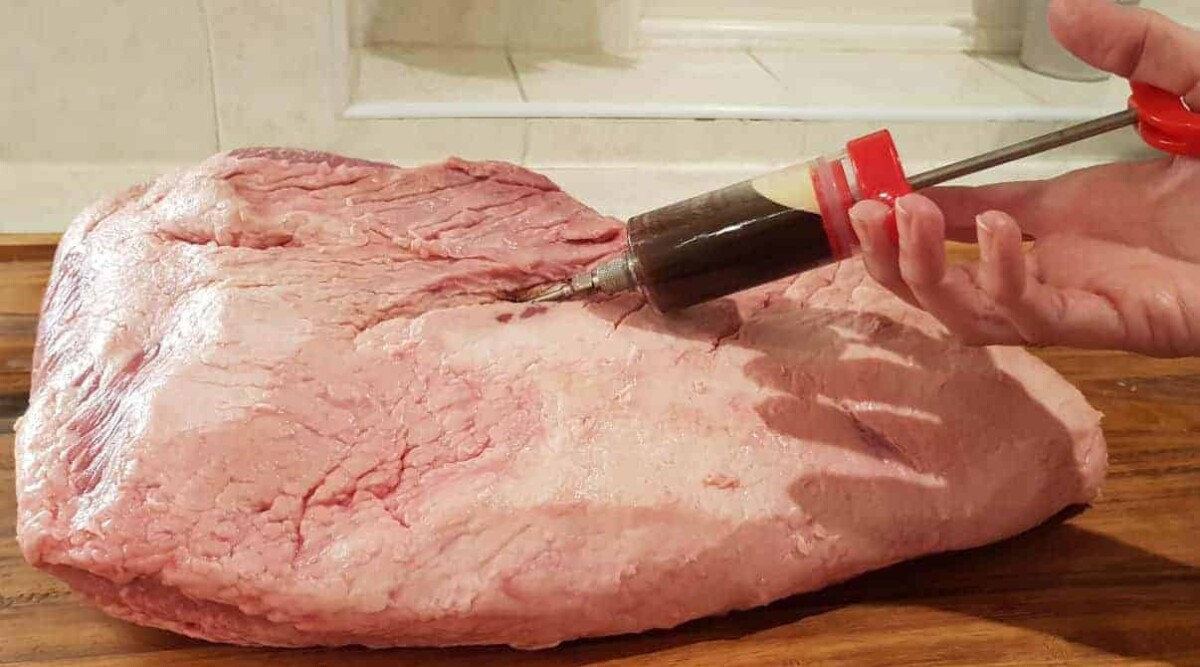
Injection is one method for boosting the moisture content of a brisket and can go a very long way toward preventing turning out boot leather.
This technique can be used for any large meats that go on the grill or smoker. There are different takes on ingredients and on time between injection and cooking, but there are a few standards by which everyone abides.
Brisket comes from the chest of a steer, a muscle responsible for holding 60% of its 1600-plus pounds. It’s a very hardworking muscle making it a tough cut to work with. So how a brisket is prepared (and sliced) makes all the difference between a tough dry ‘bleh’ to a tender, flavorful eating experience.
Let’s take a look at the why, how, and what of brisket injection, so you’ll know all the ins and outs. But first, we provide some recipes and instructions for you try this technique yourself.
3 Very Good Beef Brisket Injection Recipes
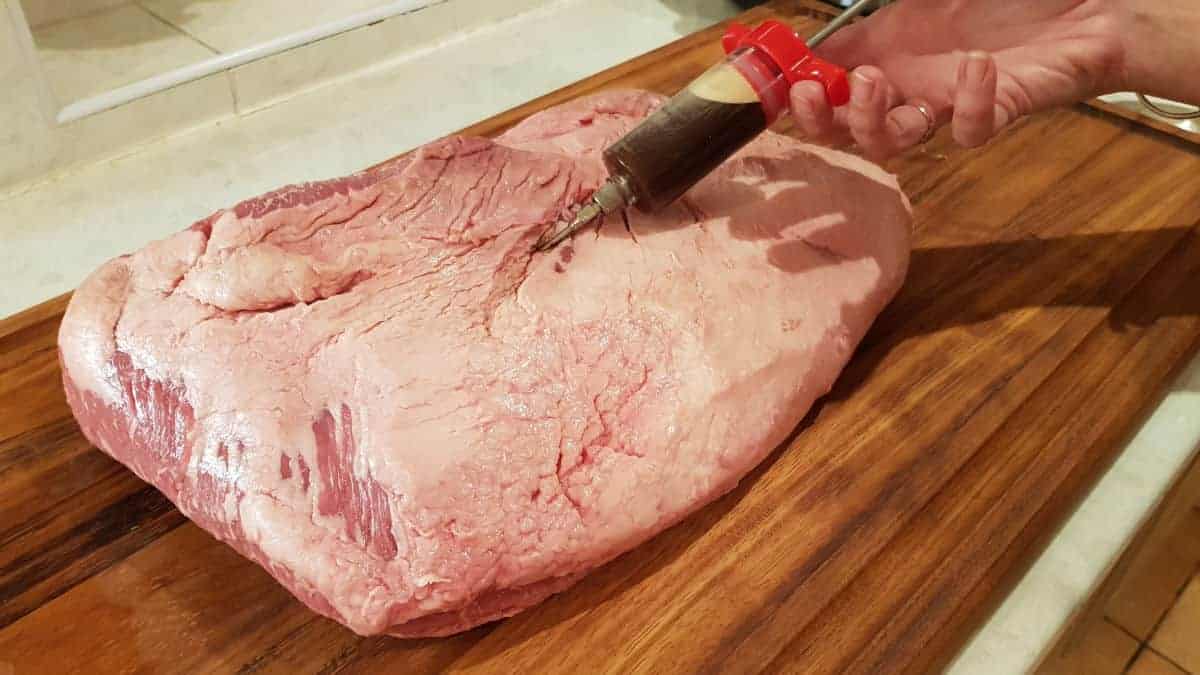
Simple things work best; a good injection solution can be as simple as salt water, low sodium stock, or salted butter. Salt is an important ingredient; it’s what will capture water and keep the meat from drying out.
Recipe #1: Competition BBQ Beef Injection
- Beef base
- Worcestershire sauce
- Soy sauce
- Accent
- Water
This injection of barbecue champs is simple and all about the beef. Though the salt factor may be overdone since every ingredient except the water contains sodium.
Accent promotes itself as a salt alternative and of providing umami, that elusive meaty / rounded / savory fifth taste.
Many people react badly to monosodium glutamate; umami can also be had from foods high in mushrooms, anchovies, miso, and other foods naturally high in glutamate.
This key amino acid is responsible for how cells work and is also a neurotransmitter. It’s good for enhancing flavors, too. In its natural form, glutamate may not trigger a reaction as MSG does, but proceed with caution.
Recipe #2: Beef or Venison Brine Injection
- Kosher salt
- sugar
- Worcestershire
- Water and/or low sodium beef stock
- Umami
- Herbs and spices
- Oil
Meathead gives an outline of different injections, including beef.
I appreciate the restrained use of sodium and the allowance for personal taste in choosing herbs and seasonings.
He allows for the addition of MSG but, again, my preference would be a natural source of glutamate, like mushrooms. (What’s better than beef and mushrooms?) The oil is an interesting addition.
Recipe #3: Savory Beef Stock Injected Beef Brisket Flat
- Kitchen Basic’s Beef Stock
- Thyme
- Rosemary
- Garlic
- Pepper
- Worcestershire sauce
- Bay leaf
This injection liquid is cooked, strained, and refrigerated overnight.
I like that the salt sources are few and the seasonings very basic. The herbs are allowed to infuse the liquid before straining them out, so there’s no worry of clogging the needle while injecting.
The brisket is left tasting like nicely seasoned beef, nothing more, which how we think it should be, while still adding moisture and keeping the end product nice and tender.
Brisket Injection — Why? How? Tools and More
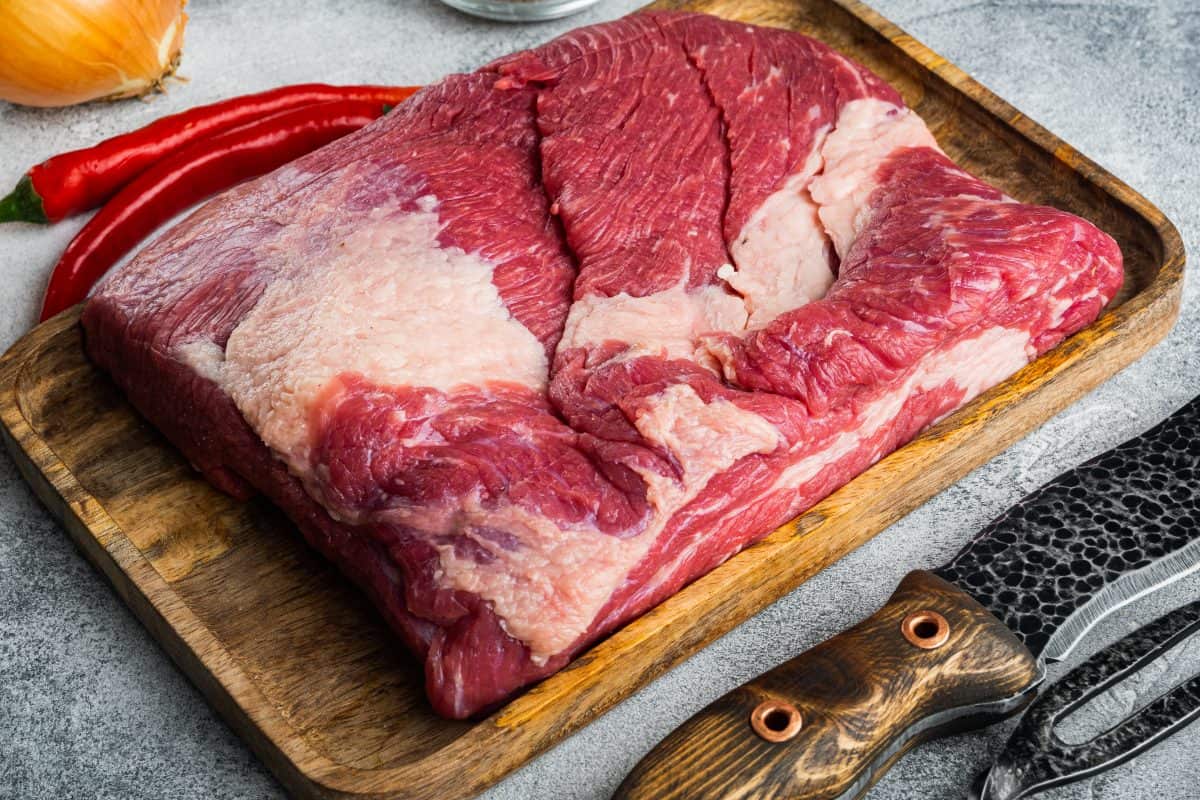
Injecting your brisket is the method of delivering fats, seasonings, and other flavorings deep below the beef’s surface.
It’s a relatively straightforward and quick process which will help the brisket, especially the flat, retain moisture as it smokes low and slow.
Butcher BBQ gives a pretty good tutorial but cheerfully ignores what seemed to be one of those standards by injecting across and with the grain.
Marinade vs. Injection
A marinade will only saturate into the outer surface of a brisket, all the seasoning stays on the outer rim. That leaves the bulk of the meat without any flavor or moisture-enhancer.
Injection carries the flavor deep into the meat. You could combine the two, marinade overnight in the fridge, pat it dry, bring it up to room temperature, inject, and put it on the fire. But personally, we think this is a bit overkill, with injection followed by a dry rub being all a piece of meat needs.
Can I use a Marinade as an Injection?
You can, but with a few adjustments.
If the brisket will be injected the night before it’s grilled, you won’t want to use a marinade with a high vinegar or citrus level. Too much time and vinegar will turn the meat into mush as the acid breaks down the tissue. Compensate for a high vinegar content in a marinade by thinning with water or marinating for a few hours shorter.
Nor would you want to use a marinade containing pineapple overnight because it contains bromelain. According to HowStuffWorks, this enzyme is found in the stem and juice of the fruit.
Although bromelain (or pineapple juice) is sometimes used as a meat tenderizer, if it’s in contact with meat for too long before cooking, It will break down the collagen into a mush. And there’s a lot of collagen in brisket so… yeah, avoid the mush if using pineapple and only apply it for just a few hours before it goes into the smoker.
Flavor Overload
You’ll find many injection recipes calling for Dr. Pepper, cola, coffee, and various fruit juices. Some will also have a plethora of seasonings. This can result in your brisket tasting like barbecued soda, not meat.
The goal should be to enhance or complement the natural flavor of the beef while preventing the meat from drying out. Like so many things, yes you can do it, but why would you?
Now that we’ve covered the why and the what, let’s get to the how of injection.
The Right Tools
An injector has a sharp point, but the liquid is dispensed through holes along the sides of the needle. The point just gets the liquid deep into the brisket.
Injectors come in various sizes, if you’re going commercial or have a lot of briskets to get through, you may need something resembling those pump sprayers used for gardening. But for home use, a small or large hypodermic-like needle is sufficient.
Needle size depends on what you’re injecting: Liquids with little or no sediment (pepper granules or bits of herbs), or thick pastes like pesto, jerk seasoning, or Romesco.
Stainless steel will hold out longer than plastic and won’t hold smells and oils like plastic can, and nor will it react with foods such as copper or aluminum can.
Two ounces should be the minimum amount of liquid the injector can hold.
Hand grip can range from a straight or 2-finger plunger to a spring-grip plier.
Deep container to accommodate the injector. Some will use a tall glass, others a large mixing bowl or measuring cup. The goal is to fill the injector easily without damaging the needle.
Which Part of the Brisket Should be Injected?
Although if you have a full packer brisket all parts can benefit, as discussed in our article on the brisket point vs flat, the flat benefits the most as it’s the leanest part and therefore the most likely to dry out during cooking.
Since the second reason for injecting brisket is to enhance flavor, the fatty point can benefit too, but it’s more for taste than for retaining moisture.
The simple Steps of Injecting a Brisket
- Inject with — or along the same direction of — the grain, to prevent dotting the meat with holes and creating unappetizing-looking streaks if you’re in competition or prefer. But going AGAINST the grain will get more injection into the meat and result in a moister cooked brisket.
- Insert the needle between or through the muscle fibers and bundles.
- Inject every 1-2 inches in a grid pattern across the whole piece of meat, to ensure an even distribution of liquid.
- Depress the plunger while withdrawing the needle.
- Mop up excess liquid. Be warned, there will be a lot and this is a messy exercise.
Here’s a brief discussion and demonstration of the steps to injecting brisket:
What’s in the Injection Solution?
The liquid can be as thin as broth or be thick and heavy with spices. There are a few commonly used ingredients, from standards like
- Butter
- Beef stock or broth
- Brine
- Alcohol
To interesting ingredients like
- Pepper
- Worcestershire sauce
- Apple juice
- Garlic and herbs
Two competition-winning commercial injection solutions, Fab B Light and Butcher BBQ Brisket Marinade, contain food-ish ingredients such as
- Hydrolyzed soy protein
- Sodium phosphates
- Monosodium glutamate
- Autolyzed yeast extract
- Disodium inosinate
- Quanylate
- Gum
- Partially hydrogenated vegetable oil
Bottom line, consider what you want your beef to taste like and what you want in your food. Like so many things, you could inject all sorts of things into your meat or poultry of choice, but it doesn’t mean you should.
What have you tried?
What do the Experts Use?
- Meathead Goldwyn of Amazing Ribs uses beef broth since the goal is to boost moisture content.
- Steve Raichlen of Barbecue! Bible makes a more complex beef brisket injection recipe using:
- Broth or stock
- Melted butter or olive oil
- Cognac or whiskey
- Hot, Worcestershire, fish, or soy sauce
- Fruit juice, molasses, or honey for sweetness
- Aaron Franklin, guru of all things brisket, doesn’t use any injection in his recipe.
How Much Injection Should be Used?
Meat is muscle which is saturated with water (up to 85% of muscle is water) so it won’t take more than a few ounces of liquid.
A good ballpark figure is a 1:1 ratio of liquid ounces to pounds of meat.
How Long Before Cooking Should I Inject the Brisket?
Some grillers will leave the injecting until right before grilling. Others will inject and refrigerate the brisket overnight.
There doesn’t seem to be a consensus on why one method is better than the other. One of the selling points of injection is that it’s a fast way to deliver moisture and flavor, unlike a marinade which requires hours of soaking.
So we’re in the camp of injecting just an hour or so before cooking.
Conclusion
While many people agree with Franklin’s view that injecting brisket is unnecessary, probably just as many are all for it.
The end takeaway: A tough cut of beef is made tender and moist with the beef flavor augmented when using a good injection recipe. Sure, there will always be some who like hitting the seasonings hard, but you can also be quite subtle and complementary to the beef.
What’s your preference?
If you have a comparable alternative to the award-winning but alarming-ingredients Fab B Light or Butcher BBQ Brisket Marinade, PLEASE, do share it with us!
Happy grilling!


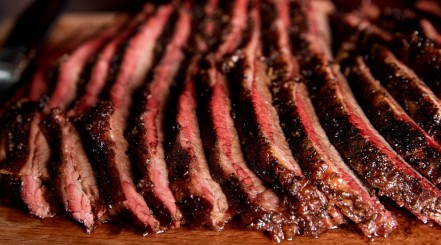
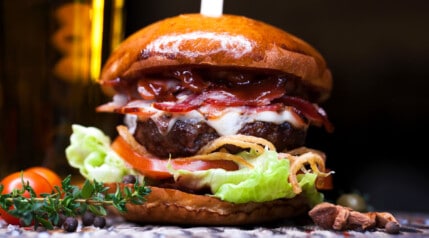
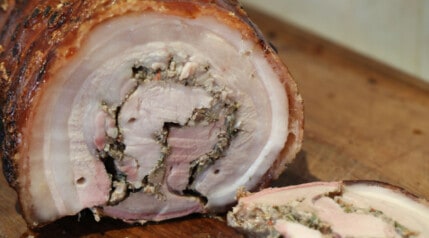
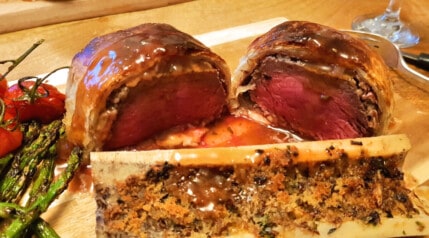
The recipes for injection into beef brisket do not have the proportions listed. I am interested in recipe 1. Can you provide me the proportions of each ingredient? P.S. I have a Bradley smoker and I love it.
Hi Jack,
Because the rub recipes are not mine, we like to link to the original source of the recipe where the ingredients, quantities and instructions for making it can be found. It’s a courtesy and respect for the original rub developers, so they receive site visitors to check out their original work. I don’t wish to take credit for their work, or to ‘copy and paste their work onto my site’ as this would be somewhat morally wrong.
So yes, please follow the links to the original source. Then you will find all quantities and instructions there.
Thanks,
Mark.
For anyone searching the internet for ACTUAL first-hand experience with pineapple and kiwi juice, DON’T DO IT!!!!!!! Did two roasts today. Kiwi marinade for 3 hours before hitting the smoker. Outside 1/2″ turned to complete mush, the consistency of liverwurst. The one with pineapple was an injection immediately before putting it on the smoker. The inside was basically mush as well, and had a pineapple flavor. You could tell all the places where the injection needle went. Don’t do it, unless you want to destroy your roast, or even worse, as brisket.
Hi Rudy,
None of the recipes for brisket injection we recommend above contain either Kiwi or Pineapple. Did you mean to leave this comment on another article on the site? We do mention pineapple in our article on how to tenderize meat for instance, where it makes sense and is useful for the task.
It is stated above that a pineapple’s enzymes act as a tenderizer to collagen, so it’s not great to use in a brisket injection, and we do not mention Kiwi in this article at all.
However, I have heard of people using either pineapple or kiwi in injections within just a few hours before cooking, so I know people do use it. Therefore, your experience is a good warning to others who may be considering using it in a brisket injection and to either tread carefully or avoid it all together. Personally, I never inject any meat with Kiwi or Pineapple at all.
Being new to the smoking process (so new that my smoker was just ordered last night), the information is very informative and appreciated! Especially warning of pineapple, (at which is saddens me).
Thanks, Tony 🙂
You could perhaps try some pineapple in your pork — just go easy with it! Try it on a small, inexpensive cut first and see how it goes and how you like it.
I make a very simple injection for beef. 1 cup beef broth, 1/2 cup non-flavored black beer (choose your favorite and finish while letting the brisket rest), 1/3 cup Worcestershire sauce. Sandy Philips, MOAC Smokers
Sounds like that would work for me…especially the drinking of unused beer 😉
But seriously, all good flavors that go with beef, and are all three ingredients I include in the braising liquids when I do an oxtail or beef shin stew.
Love the Site.
Thanks, John, nice to hear 🙂
Has anyone tried Arby’s au jus by any chance? I think I might try that. It shouldn’t be too strong.
Good info! Fairly new to smoking and have done some real delicious things so far, but kinda nervous to do a brisket for the first time. That’s an expensive chunk of meat to potentially ruin, but I think I’m going to try it this weekend. Thanks!
Hi Justin,
I would recommend doing a ‘brisket point’ only first time, as they are far more forgiving, and being only half a brisket will reduce the costs considerably!
Do you find a difference in using beef stock vs beef broth with your injections?
Thanks
Hi Geoff,
To be perfectly honest I tend not to inject and have only done so out of curiosity, and to see how it compares. And when I have injected, I used stock. I have never injected broth.
They are made very similarly and are pretty much interchangeable though, so either can be used. I think (and may well be lacking some of the finer nuances between the two) that stock and broth are the same except that a stock is made from boiling bones (sometimes roasted), and broth by boiling meat, and also that a broth is more ‘seasoned’ than a stock. So flavor profiles are similar, except a stock will be more gelatinous due to having boiled bones, and a broth will be a looser liquid and have a saltier, more seasoned taste.
Used as an injection though, and particularly after using a rub, adding some smoke etc. I really don’t think there’d be much taste difference resulting from using one or the other for an injection.
Hopefully somebody else who has tried both can chime in with a better opinion than mine!
Enjoyed this article very much. I’m always looking to improve my “Q”. I usually just go with a beef broth injection, However, I am intrigued with injection recipe #3. What do you think about a little bourbon added to it?
Hi Moose,
Not sure, but I LOVE bourbon (I regularly make Old Fashioneds at home) so pretty sure I’d enjoy it, haha.
If you’re going to try it, I would boil off some bourbon separately before adding it to the mix. Because it’s injected, if you don’t do this, I strongly suspect not all the alcohol will boil off during cooking, so it could be very ‘boozy’, where you just want the bourbon flavor, as opposed to any of the alcohol content.
If you try it, let us know how it goes?
Very informative, was laid out as the perfect explanation to answer my minds ramblings regarding brisket injecting.
Thank you for the direction!
Tarby — UK
Thanks, Tarby, I’m glad it helped 🙂
Love brisket. Fortunate to have a source of grass fed beef. Corned beef, pastrami, smoked brisket. Make my own broth for injecting, so I have control of ingredients. Jerky, sausage and burger have been known to benefit. Take your time, know your ingredients for rubs and injecting and above all enjoy the experience. Thanks, for the post.
I’ve never made pastrami. Every time I see someone else’s efforts I always promise myself I will, but never seem to get around to it. I should make it my mission.
Hi Mark, Louie from Australia here 🙂 Love reading these things, learning a lot as I am a beginner. I have made up my own rubs and injections that I absolutely love. I think that there is no right or wrong way when it comes to injections and rubs (within reason of course if you stick to the basics). I would love to get your opinion on these ingredients as every time I smoke meat there is nothing left over lol. I will tell you what I use for pork shoulder. DRY RUB: 2 TBSP of Sea Salt, Cracked Black Pepper, Onion Flakes, Cumin and Paprika and 1 TBSP of Garlic Powder. I also rub on some Dijon Mustard all over for the dry rub to stick on. INJECTION: Approx 10 parts Apple Juice (the sweeter, the better), 3 parts balsamic vinegar (syrup if possible), 1 part white vinegar and 1 part vegetable oil. Adjust as needed. I know that it sounds acidic, but it’s actually pretty sweet and compliments the pork. I inject overnight and then after 3hrs of cooking and every hr after that. Would lo s to get your feedback. CHEERS
Hi Louie, thanks for taking the time to comment 🙂
I think you said it all here: “I think that there is no right or wrong way when it comes to injections and rubs” — Basically, I agree. It’s a personal thing. Though if feeding a crowd, there are rules to abide by, and you can’t go too far off track!
All your ingredients look right to me, are ones popularly used, and definitely taste great. The proportions / ratios of each to use, just play around with to get exactly what you prefer. Just change one ingredient up or down each time you make the rub and see what works.
It sounds to me like you’ve been doing that and have found your sweet spot anyway?
I would say for me personally (and it does not mean I’m right, just personal taste!) your rub on pork I would cut the pepper in half, and add a healthy dose of sugar to it. If I’m reading it right, it adds up to about 10 to 11 TBSP, so I’d add in 5 or 6 tbsp. of sugar, 4 brown and 2 white. Pork loves sugar, it tastes great and helps create a really deep and chewy bark over the duration of a long slow cook.
Hahaha wow, it’s funny you say that about the sugar, I actually smoked another pork shoulder the day after I wrote that letter to you and I did add sugar. I didn’t put the amount you said, and I didn’t use both brown and white sugar, I only added 2 tbsp of brown sugar just to try it and I loved it. I also didn’t take out any pepper, however I will try exactly what you suggested the next time. I really appreciate your reply, to be honest I didn’t think I’d get one lol. I think I must be doing something right because I never have any meat left over and all my mates keep coming back lol
P.s, to answer your question about the rub ingredients, yes, I have played around with them and for me (and I guess for my guests) we have come to that combination as being the favorite one (the sweet spot).
Regards Louie
I try to reply to every comment, it’s the only decent thing to do…and I like to chat 🙂
“I think I must be doing something right because I never have any meat left over and all my mates keep coming back lol” — That’s the true sign of ‘doing it right’, not just pleasing yourself, but for others too. Got to be careful though, you’ll be spending a fortune on keeping everybody well-fed! Haha.
Recipe #3 sounds a lot like my beef gravy recipe without the thickening agents.
Sounds about right. Many people inject with a beef bone broth or stock, which is pretty much a very flavorful thin gravy.
I have a venison brisket from a moose. It’s not all that big and has virtually NO fat on it whatsoever. So I’m hoping injection, along with a bacon wrap will help keep this thing from drying out.
Any suggestions would be greatly appreciated
Hi Grant,
I think if you cook it like a beef brisket, it’s going to be dry and perhaps disappointing. Injecting will help, as will a bacon wrap. But honestly, I think I would smoke and then braise it. This might not be the end result you want — if a beef brisket type finish is what you’re after — but I think it’s the safest bet to get a good result from what is a lean piece of meat with no fat cap.
So personally, I would rub it, then smoke it until approx 165F internal, then place into an aluminum pan with a good half cup or so of beef stock a dark ale, or whatever braising liquid you prefer. Seal it with foil, and from there continue to cook until it hits somewhere around 200F, then check for probe tenderness.
I think this is the safest way to do it. Though the bark will likely be a bit underwhelming, it will still be plenty flavorful, and the meat should still be wonderfully moist.
Let me know which way you decide to go and what the end result is, I’m super interested!
Thanks for the good information here. I don’t like to crutch my brisket, since I find that the bark gets too soft and the whole thing ends up tasting like pot roast. I’m looking at using injections in my flats to keep them from drying out. My one concern about using beef broth is that I’m concerned that it might lead to the same stewed/pot roast flavor that I’m trying to avoid. Any thoughts on that?
My other thought would be to just take some of the rub that I’m using on the outside and mix it into some melted butter or olive oil to use as an injection. Any thoughts on that idea?
Hi Eric,
Have you tried wrapping with pink butcher paper instead of foil, then unwrapping and putting back in the smoker for a few minutes to dry out the bark at the end? This might be closer to what you’re after?
As for what to use to inject with, it really is going to be a personal preference and I can only suggest trying it out to see what you prefer. You can buy a flat, halve it and try injections on each piece, no need to do a whole flat per injection. Experiment, and see what suits you as all of our tastes and preferences are different.
Brisket. Grind onion soup mix then add water, inject. I don’t think you will be disappointed.
Hi, Mark. Just discovered your site and really appreciate it. Constantly researching and reading on methods of Smoking. I have not ever injected a brisket, though. Guess I’m from the Aaron Franklin group. I’ve come to learn that time, wrap, temp, and rest are the items to focus on. Every Brisket is different and requires a good watching. However, I always inject Pork Shoulders. Thankfully Pork is very forgiving.
Hi, August. I rarely inject briskets myself, only those that are very lean and in danger of drying out, which you can see clearly when you are trimming it.